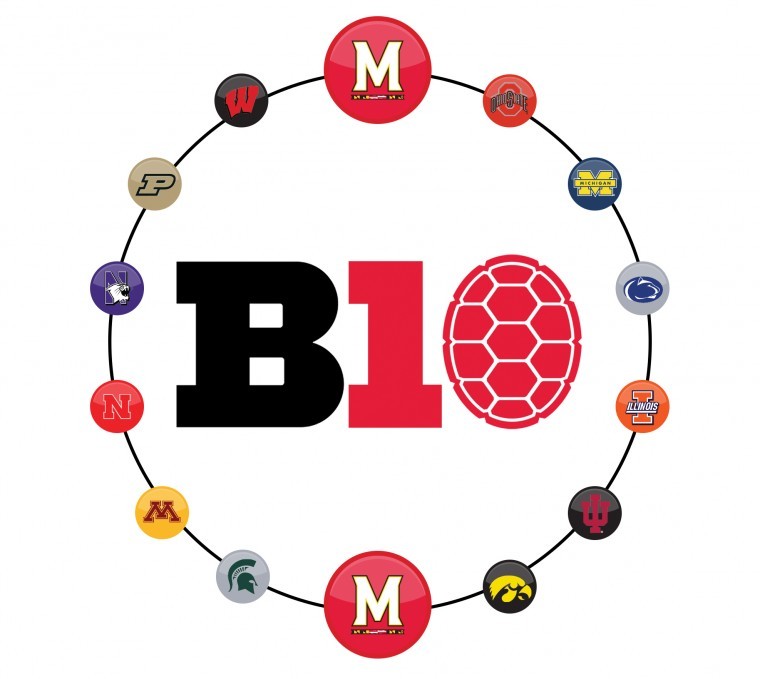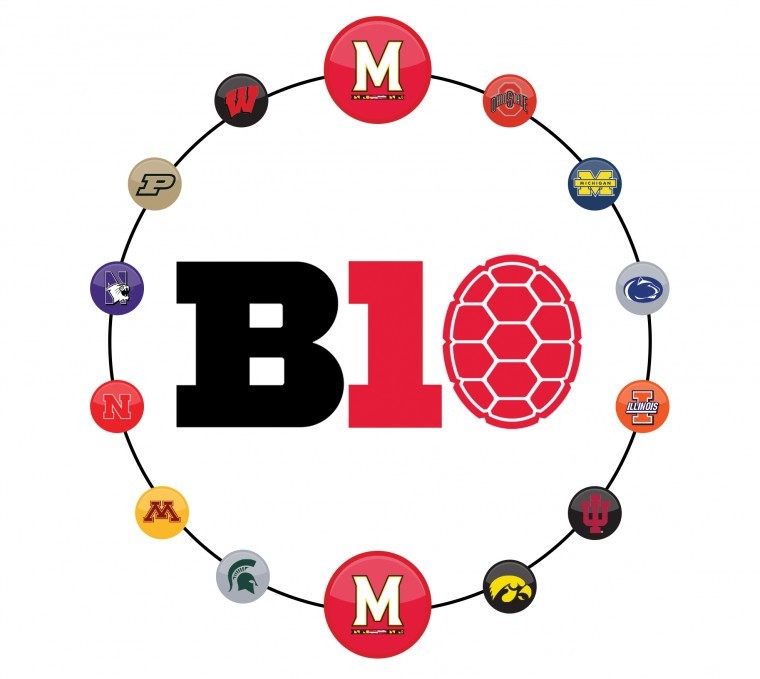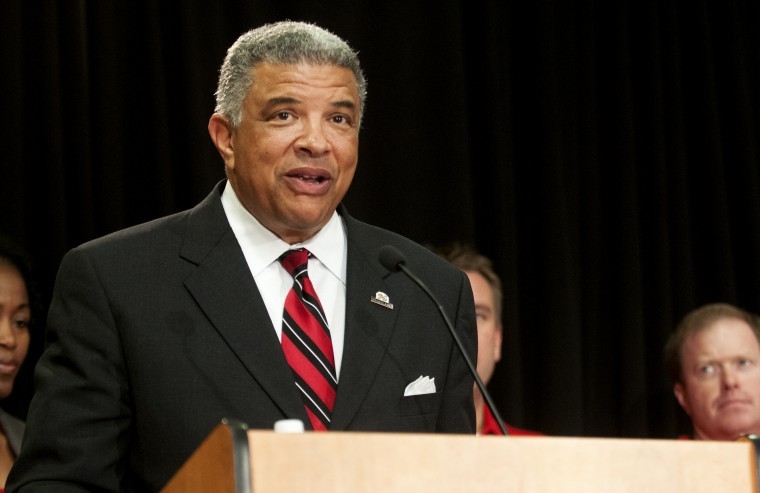The university is leaving the ACC for the Big Ten in 2014, university President Wallace Loh announced yesterday.
After about two weeks of discussions between this university and Big Ten officials, Loh said he, along with Athletic Director Kevin Anderson, University System of Maryland Chancellor Brit Kirwan and other administrators, decided it would be the best move economically and academically for the university. Rutgers is expected to announce today it will join the conference, according to ESPN.
“This will guarantee the financial stability and health of Maryland athletics for decades to come, and I’ve got the numbers to back it,” Loh told The Diamondback. “We’re living paycheck to paycheck, but we’re doing okay. But let’s say attendance goes down or our fundraising is not as good. In three or four years, I may have to cut teams again.”
Although the ACC raised its exit fee from $20 million to $50 million in September — a move Loh voted against because of “philosophical and legal reasons” — Loh said officials are confident they can negotiate a lower rate, but did not specify by how much.
“We will sit down and have private conversations with the ACC about the exit fee and whatever the eventual exit fee is, my statement still stands. We will be ensuring the financial health of athletics,” Loh said.
Loh, Kirwan, Anderson and Big Ten Commissioner Jim Delany held a news conference yesterday in Stamp Student Union to announce the decision and explain the move. While university administrators said the financial stability associated with joining the Big Ten was one of the most critical factors in the decision, they also pointed to the academic benefits of joining. The conference is revenue sharing, meaning the university will receive an equal share of the money generated each year.
Big Ten schools, along with the University of Chicago, make up the Committee on Institutional Cooperation, which is a collaborative relationship between all member schools that offers each university access to common data, libraries and study abroad programs. The schools can also order supplies, such as computers, in bulk for discounted prices. Loh said he may not have wanted to join the conference if it weren’t for the consortium.
“I have a responsibility to the entire university,” he said at the news conference. “It’s not just about the sports fans.”
“I support the move largely because of what it means to the institution academically,” Kirwan said. “Having been a president in the Big Ten [at Ohio State], I know it is not just athletics, it is an alliance.”
The Big Ten is expected to give each member school $24 million by the end of the fiscal year. ACC schools will receive about $17 million a year through 2027 from the conference’s contract with ESPN, plus an addition of at least $1 million more per school because of Notre Dame’s recent move.
The Big Ten, however, has its own cable channel — the Big Ten Network — which has grown into a global brand.
With the economic benefits the university will reap from the move, Loh and Anderson said they will be able to bring back some of the seven teams that were cut in July.
“When we came in two years ago, Kevin Anderson and I were faced unexpectedly with budget deficits,” Loh said. “I want to leave a legacy where no president will have to wonder whether Maryland athletics will survive.”
“We have done so much with so little for so long — now imagine what our teams can accomplish with the financial stability we can give them,” Anderson said. “No future athletic director will have to look into a young man or young woman’s eyes and say that you can’t compete here anymore, you can’t wear these colors anymore.”
The university will also earmark some of the additional revenue for academic resources, scholarship opportunities and improved student-athlete resources, Loh said.
The official announcement was not unexpected. Loh negotiated with Big Ten officials for about two weeks before rumors began to spread online over the weekend. The Board of Regents “overwhelmingly” voted to support the move, Kirwan said.
Upset students took to social media, flooding the “Maryland Terrapins” Facebook page to voice their discontent.
Many at the conference asked why they were left in dark about the negotiations, but Kirwan said the Board of Regents was in full compliance with the attorney general’s policies.
Because fans are so emotionally tied to their teams and schools, Delany said, opening the move up to public discussion would cause more harm than good, as he said he experienced when the Big Ten announced three years ago it planned to bring in another school, which wound up being Nebraska.
“It was beautifully transparent and beautifully dysfunctional,” he said.
Anderson said officials are nervously anticipating fewer donations, but he believes donors will continue to contribute after the initial shock of the move wears off. Anderson pointed to conversations with Under Armour founder and university alumnus Kevin Plank, one of the university’s most prominent donors, who has embraced the move.
Loh and Anderson said it was an emotional and difficult decision to make.
“[Meeting with the coaches], at first it was like going through the process of grieving,” Anderson said, adding they are all in agreement the ACC exit is a means of moving forward.
The Student Government Association’s Executive Board also endorsed the move, writing in an open letter to the Board of Regents, “Although we mourn the traditions that would inevitably be lost, joining the Big Ten would fundamentally transform our university for the better.”
This university was one of the ACC’s seven founding schools, teaming up with Duke University, the University of North Carolina, North Carolina State University, the University of South Carolina, Wake Forest University and Clemson University in 1953.
Previously, this university helped found the Southern Conference in 1921 .
“I understand that many devoted Terp fans may be stunned and disappointed at this news,” Loh wrote in a letter to the university community. “To them, I ask only this: please understand that I am doing what I believe is best for the University of Maryland and all of its stakeholders — students, faculty, staff, alumni, donors, and sports fans.”
The move to accept Maryland as the Big Ten’s 13th member is symbolic for the conference as well, as it seeks to expand and grow to include more of the East Coast. Delany, however, would not comment on further expansion and said, “This is Maryland’s day.”
“When I think about the kind of institutions I think it’s important for us to play against, I view Maryland as an outstanding partner,” said University of Michigan President Mary Sue Coleman.
Adding another school — or possibly two, depending on Rutgers’ announcement — also impacts Big Ten fans. They, like Terp fans, harbor some discontent, Delany said in a teleconference following the news conference.
“I think it’s very natural for people to reject and push change away,” he said. “But making decisions like this, you weigh the risks with the rewards. … I’m very comfortable with where we are and over the long term, we’ll see tremendous benefits from this.”
Athletic Director Kevin Anderson speaks at the press conference announcing Maryland’s entrance into the Big Ten conference. He announced Tuesday that men’s track and field will continue for another two years prior to the university’s move to the Big Ten.





